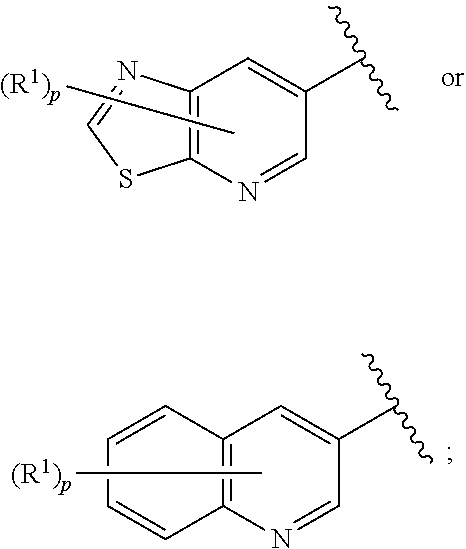Inhibitors of MALT1 and uses thereof
a technology of malt1 and inhibitors, applied in the field of compounds, can solve the problems of poor outcomes of patients diagnosed with the abc subtype and gcb patients, and achieve the effect of inhibiting its constitutive proteolytic activity
- Summary
- Abstract
- Description
- Claims
- Application Information
AI Technical Summary
Benefits of technology
Problems solved by technology
Method used
Image
Examples
examples
[0471]In order that the invention described herein may be more fully understood, the following examples are set forth. The examples described in this application are offered to illustrate the compounds, pharmaceutical compositions, and methods provided herein and are not to be construed in any way as limiting their scope.
[0472]Compounds of Formula I were prepared using the synthetic schemes and procedures described in detail below.
Preparation of Synthetic Intermediates
4-Bromo-6-chloroquinolin-3-amine (E)
[0473]
5-Chloro-2-(2-nitrovinylamino)benzoic Acid (B)
[0474]Nitromethane (26.8 g, 440 mmol) was added dropwise to a solution of NaOH (26.8 g, 670 mmol) in water (60 mL) while keeping the temperature at 20-30° C. The resulting mixture was then warmed to 40° C. and stirred for 10 min. The mixture was cooled to 20-30° C. and another portion of nitromethane (13.4 g, 220 mmol) was added. After complete addition, the reaction was stirred for 1 hour at 45° C. The red solution was then heated ...
PUM
| Property | Measurement | Unit |
|---|---|---|
| w/w | aaaaa | aaaaa |
| temperature | aaaaa | aaaaa |
| temperature | aaaaa | aaaaa |
Abstract
Description
Claims
Application Information
 Login to View More
Login to View More - R&D Engineer
- R&D Manager
- IP Professional
- Industry Leading Data Capabilities
- Powerful AI technology
- Patent DNA Extraction
Browse by: Latest US Patents, China's latest patents, Technical Efficacy Thesaurus, Application Domain, Technology Topic, Popular Technical Reports.
© 2024 PatSnap. All rights reserved.Legal|Privacy policy|Modern Slavery Act Transparency Statement|Sitemap|About US| Contact US: help@patsnap.com










